Starting with Shotokan Karate Founder Gichin Funakoshi, Hidemine Jibiki (地曳秀峰) has a resume that is as varied as it is impressive. Born in 1927, his studies progressed from Okinawan Karate through Japanese Hakko-ryu Jujutsu and Daito-ryu Aiki-jujutsu to Chinese internal martial arts and more.
This is the second part of an excerpt from an interview in Japanese with Hidemine Jibiki, in which he discusses his experiences in Daito-ryu with Tsunejiro Hosono Sensei and Kotaro Yoshida Sensei, including some anecdotes of Daito-ryu Chuku-no-so Sokaku Takeda. You may want to read Part 1 of this interview before reading this section.
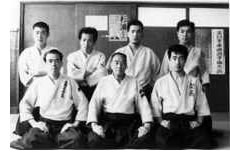 Hidemine Jibiki at Hosono Dojo
Hidemine Jibiki at Hosono Dojo
Hosono Dojo Shihan-dai
In Hidemine Jibiki’s Budo life training in Aiki Budo becomes even more complete through Tsunejiro Hosono’s instruction. Not only the content of his technique, but also his very way of thinking undergoes a transformation. It is in this period that the the first period of Hidemine’s true Budo training, “The Road To Softness”, begins to flower.
Q: Could you speak a little bit more about your time with Tsunejiro Hosono Sensei?
A: Hosono Sensei taught Judo as well as Aiki Budo at his dojo after he retired . He would treat people as an osteopath he would teach that as well. Because he was such a busy person I would work as the Shihan-dai at the dojo on Friday evenings and Saturday. This was around the time that Mr. Kondo, who is now the Daito-ryu Aiki-jujutsu Soke-dairi (大東流合気柔術宗家代理) joined the dojo. He was still a student at the Chiba Institute of Technology (千葉工大), and I gave him his first training. I still have a picture of us together!
Q: At the time Tomiko Sensei (Hidemine Jibiki’s wife) was also training together with you.
A: Many people stop training after they marry, so I needed her understanding in order to continue. Happily she had an interest in it….
Q: What was your impression of Hosono Sensei?
A: He was an educated person who followed the dual paths of literary and martial arts (“Bunbu Ryodo” / 文武両道). A warrior from the past, he had the feeling of a feudal lord’s chief retainer, and a mild disposition. When it came to technique he was a professional Budo-ka. One time there was a man who, boasting of his skill in Karate, suddenly come in with a kick. Without changing his expression, Sensei reversed his leg in a flash. I thought then that he was a real master.
Organizing an Aikido Club at the American Army Base
Q: What about on weekdays?
A: I was at the American military base in Kisarazu, so I got permission from Hosono Sensei to open a branch dojo there. I registered with the Kisarazu Budo Renmei (木更津武道連盟) and then taught there after work.
Q: Was there a lot of Budo in the Kisarazu area?
A: Since it was an imperial fiefdom under the direct control of the shogunate the shogun’s direct retainers had villas there, and it retained the atmosphere of old Edo.
Q: What kind of students did you have at the branch dojo?
A: That was the time of the Vietnam War. Most of them were in the Navy, and scheduled for deployment to Vietnam. It was said they were the strongest among the three services, all of them were tough young men of 180cm or more. They had to fight in the front lines, so it was meaningless unless the techniques could actually be used. A person who couldn’t show real power when tested by the Americans would never be recognized as an instructor. At first they would come at me with incredible momentum, but I would toss them without reservation. (laughing) Anyway, since I was so much smaller than they were they would be really shocked when that happened. (laughing) I taught them mainly close quarters combat. It really taught me a lot, the enemy was the enemy, so half-baked techniques wouldn’t work.
Q: Do you remember any of the students?
A: There was a champion body-builder. He was a farmer, so he converted a barn and four of his family would train there. During the winter snows the four of them would lift up trucks to shovel away the snow from under them. Because this was a man who was confident in his strength, at first when he watched practice he would make fun of it half the time – “Instead of putting them face down why don’t you just grab them and throw them?” – I got tired of his attitude and said “If that’s what you think then try and grab this!” and had him grab my lapels. When he tried to hold on with strength I threw him and held him down so hard that he couldn’t even speak. (laughing) Because between strength and Ki, Ki is always stronger. Then, on the next day he came back changed into a completely different person and begged for teaching. (laughing) After that he applied himself regularly to the training with great enthusiasm. After returning to the United States he opened a dojo. He sent me an 8mm film, the students were bowing from seiza and he appeared in a hakama, just as I taught him. (laughing) There was also a person who was the U.S. National lightweight boxing champion. He didn’t tell me that until the very end, but then I realized why he’d been able to strike so quickly! (laughing) Even then, when one applies Aiki techniques everybody is the same. It must have been the same for him as it was when I was thrown by Okuyama Sensei, it must have been a complete mystery. Anyway, at the time I often thought that it was a good thing that I was doing Daito-ryu Aikido. That is, when I watched Budoka in other types of Budo I would often see them struggling and hard pressed to handle their large foreign opponents.
The Self Defense Forces Aikido Club
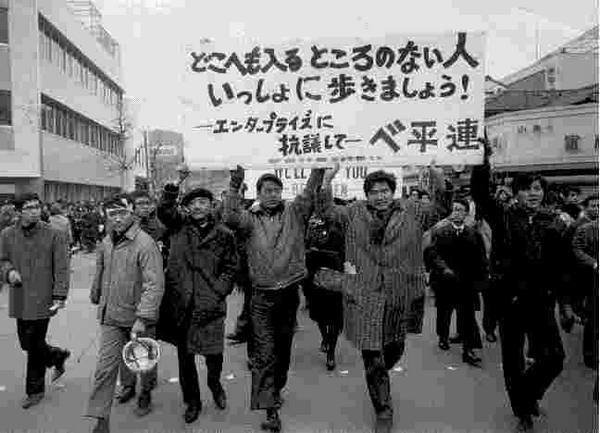 The Beiheiren Protests the arrival of the U.S.S. Enterprise in Japan, 1968
The Beiheiren Protests the arrival of the U.S.S. Enterprise in Japan, 1968
Q: Were you asked to teach the Self Defense Forces?
A: The Kisarazu Base was used jointly by the American military and the Self Defense Forces. This was the time of the Beiheiren (Translator’s Note: べ平連 – the most prominent anti-Vietnam peace movement in Japan), so the armory was often a target and there were some fatalities. The students would join hands and sit-in in front of the main Self Defense Forces gate, and they came with the mass-media so that they couldn’t just be cleared away. It was a time when the Self Defense Forces eyed the mass-media as an enemy. When injuries occurred among the students it would become the top story on page one of the newspapers. That was why I received a request from the Self Defense Forces to teach a method for clearing them away without causing injuries.
Q: Does such a method exist?
A: It’s simple if one uses soft techniques! Techniques from Hakko-ryu proved quite useful at that time. No matter how hard they struggled to remain seated, one could just smile and grasp their pressure points and the students would become unable to remain sitting. (laughing) Then you could forcibly remove them. I also taught them things like techniques for subduing an opponent wielding an iron pipe and methods for forcing someone to walk in front of you while you escort them away.
Q: The person being escorted away walks in front?
A: From the outside it looks as if the student is walking in front and the officer is following along behind. (laughing) I still have the thank you cards from that time. I also have thank you cards from the American military.
What is first class Budo?
Q: Your teachers, Shotokan Karate’s Gichin Funakoshi Sensei, Hakko-ryu Jujutsu’s Ryu Okuyama Sensei, Daito-ryu Aiki Budo’s Tsunejiro Hosono Sensei and Kotaro Yoshida Sensei, and finally Wang Shujin, were all first class Budoka. Are there some points that all of them held in common?
A: Firstly, all of them were educated people. Funakoshi Sensei was a teacher, and Yoshida Sensei graduated from an Imperial university, was an editor at the Hokkaido Shimbun, and could speak fluently in English. The others were also highly educated people. The scholar Confucius from the Chunqiu Period was also a Bujutsuka, and his sword-work has been transmitted even to the present day. Japanese warriors are the same. Education and first class Budo were required to ensure the family succession. Each of the teachers were calm, polite and dutiful common sense men. Most of all, they were each teachers of high quality.
Q: The types of Bujutsuka who appear in the various MMA (格闘技) magazines appear to be somewhat coarse…
A: The image of Bujutsuka as coarse is something that was invented by the mass-media. A Bujutsuka is someone who has mastered techniques for protecting their bodies from violent people. Bujutsu is something that is only used for the protection of society or of one’s family.
A change in mindset
Q: Are there people who come to study that are attracted to MMA?
A: MMA is a sport for entertainment, it is not Budo. The proof of this is the division into classes. If a lightweight and a heavyweight were paired together there would be nothing to show. Of course the heavyweight will win. Budo is a technique for a small person to control a large person. From the beginning it has a different quality. However long one trains, if one’s body is stiff they will not be able to master the techniques. Unless there is a change in mindset there will be no technical progress, only frustration. Budo is something alien to MMA. Fortunately, in my dojo even those who are violent at first become calm as they continue their training. That is because as they continue their training they have no choice but to change their mindset. (laughing)
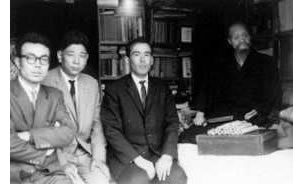 Hidemine Jibiki and Kotaro Yoshida (right)
Hidemine Jibiki and Kotaro Yoshida (right)
Meeting Kotaro Yoshida Sensei
Q: You became acquainted with Kotaro Yoshida Sensei through an introduction from Tsunejiro Hosono Sensei, how did that come about?
A: At the time I was functioning as Hosono Sensei’s Shihan-dai, and I think that is why he introduced me to Yoshida Sensei. At first there was no particular reason for the introduction, but after Hosono Sensei passed away it turned out to extremely helpful to have made the acquaintanceship.
Q: Where was Yoshida Sensei living?
A: In Hitachi City in Ibaraki Prefecture. I always visited him together with Yokota Sensei, but since I was living in Kisarazu it was difficult to go visit. In one day I would go into Tokyo, change at Akihabara and head towards Hitachi, then I’d have to change trains again once I got to Hitachi. When I look back now I think that I must really have been passionate. (laughing) Well, after that if I heard that I could learn a good technique I’d even go to Taiwan or Hong Kong… (laughing)
Q: What kind of person was he?
A: He was intelligent enough to be the editor-in-chief of the Hokkaido Shimbun, but he had the appearance of an ancient warrior. At that time he was around eighty years old, and paralyzed on one side, there were many shuriken in round pencil holders at the head of his bed. He always had an iron fan with him, and when he was healthier five Judoka approached him at a Daito-ryu Jujutsu demonstration and asked him to try applying Aiki to them – when he said “Well, in that case” and took out his iron fan they all fell silent. (laughing) Sensei’s era was a time when Budoka would give each other a try, so Sensei was the one who was tested. There were sumo wrestlers who came to ask what kind of a thing Aiki-jujutsu was, and when he said “Well, OK” and threw a shuriken into a persimmon tree in the garden they shut-up and went home. (laughing)
Q: What was the training like?
A: I had been taught enough Aiki techniques by Hosono Sensei, and I was in the period in which it was up to my own personal research. From Yoshida Sensei I learned about Daito-ryu’s way of thinking and the mindset of the warrior. When Sokaku Takeda left for his Musha shugyo (Translator’s Note: 武者修行 – a samurai pilgrimage to hone warrior skills) Sensei attended him as his assistant. He loved to be asked to talk about Sokaku.
Sokaku and Throwing Bronze Coins
Q: Could you tell us one of those stories?
A: There was a time that he stopped by Hamamatsu, and Sokaku met a man who was throwing 2-sen coins into a pine tree. A 2-sen coin was about as large as the current 500 yen coins are, and they were being swallowed up by the pine tree. Sokaku, who had practiced with shuriken, was impressed and said “Please allow me to study with you”. In his childhood the man was struck down with polio and became unable to move. His older brother became worried about his lack of exercise, so he changed a 1-yen coin into 50 2-sen coins and told him to throw them at a post. At first they would just bounce off, but after a time they started to sink into the post. The man said that it was just something that he did for exercise, so it wasn’t anything that he could teach anybody and refused Sokaku. It was said that this story moved Sokaku greatly, and that he threw himself into shuriken training with great intensity.
The old woman’s skewer throwing and the thieving cat.
A: There are more stories concerning shuriken. This is a story of the time that Sokaku stopped for a rest in a tea house at a ferry crossing during a trip to Shikoku. This tea house was famous for skewered broiled eel, and an old woman was washing the bamboo skewers at the washing place. One by one, as she finished washing them she would throw them behind her without turning around. Although she never looked at the bamboo bag behind her, the bamboo skewers were stacked up neatly on the bottom.
Q: Ehh! Is that true?
A: Sokaku was impressed by this, an began to practice throwing shuriken under his sleeves and over his shoulders. This was a journey for Budo training, so he could not neglect his own training even while he was teaching. In time, Sokaku’s party came to the Tosa area of Shikoku. Sokaku bought a bonito, and saying that he would treat them to bonito tataki, started to cut it into into three pieces. As he lined up the pieces of fish on a plate beside him a thieving cat snuck up quietly and ran away with the meat. In an instant, Sokaku threw the knife behind him under his sleeve and there was a screech that cut off right in the middle. It is said that Sokuku said “Rude fellow!”. (laughing)
Warriors Develop Hokkaido
Q: I’ve heard that Yoshida Sensei was the person who introduced Mr. Morihei Ueshiba to Sokaku.
A: Mr. Ueshiba is a person who learned Aiki-jujutsu from Sokaku, and Sensei was his guarantor. Mr. Ueshiba was a man of great strength, it’s said that he was able to lift up Sokaku while Sokaku was standing on the two palms of his hands in his magnolia wood geta (wooden sandals). He was heavily conditioned from clearing land. The majority of the members in the development group were warriors, and Mr. Ueshiba was from a warrior family. After the Meiji Restoration the warriors attached to the Bakufu at the end of the Edo Period needed some place to go, so they threw themselves into the development groups. The first development groups were all warriors, and when they turned to the group at the morning roll call it sounded like something from the military. (laughing)
Q: In other words, there was a rich Budo environment in Hokkaido?
A: Yes, that’s right. Sokaku would travel around the areas of Hokkaido teaching, with his hub in Abashiri. That must have been how he made the acquaintance of Yoshida Sensei, who was editor-in-chief of the Hokkaido Shimbun. It may be that he was the subject of an interview. Sensei came from a warrior family, vassals of the Miharu Domain (三春藩), which was near Aizu. Sokaku was from the Aizu Domain, so it must have been that they felt a connection.
Knowing the mindset of the warrior
A: Sokaku would always come up clip clopping in his geta when he came to Sensei’s place. He’d call out “Yoshida-kun, you there?” in his Aizu accent. (laughing) One winter he heated up the bath for Sokaku. The door was a little bit open, but when Sensei went to shut the door, fearing a draft, Sokaku went mad with rage. “If you shut the door how will I know when enemies come? Is this the start of a conspiracy against my life!?!” – said Sokaku. Sensei was completely taken aback. In other words, no matter what the circumstances, Sokaku was always prepared for war. This is “When a man goes out he must think that he has at least seven enemies”.
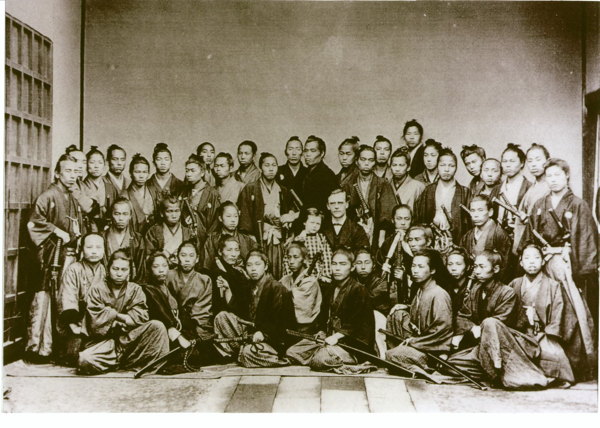 Samurai in 1868, photo by Guido Verbeck
Samurai in 1868, photo by Guido Verbeck
Sitting in Orishiki, front left
Q: That’s right out of the Sengoku Period!
A: It’s an interesting story, but it also contains some very useful points concerning the mindset of a warrior. In Hosono Dojo we were repeatedly instructed in the behavior of the warrior. We were taught not to tread on the seam of the tatami in order to avoid hidden swords, and not to open sliding screens suddenly. We also practiced “tatami-gaeshi” (“tatami flipping”), where one stands the tatami up by inserting their thumb in the seam in order to use it as a shield against arrows. When warriors ascended to the castle they would sit for the entire day, but they would never cross their legs (胡座). They would sit in seiza without even crossing their big toes. If one does this then they can straighten their big toes in and instant and stand up right away. Also, there was “Orishiki” (折敷), a way of sitting with the left knee up. This was a way of sitting in armor. The things that I learned at Hosono Dojo I explored in even greater depth with Yoshida Sensei. His stories of Sokaku’s Musha Shugyo, especially the stories of “dojo storming”, were extremely informative.
Q: What kinds of stories?
A: When he went “dojo storming” the head of the dojo wouldn’t come out in the beginning. Those below would come out one after the other, and while that was happening the head of the dojo would observe Sokaku’s skills from the shadows. At that time he would not use secret techniques, he would deal with each opponent and hide his techniques. After the Shihan’s representatives were finished the head of the dojo would finally emerge to take up the contest. Then he would use a secret technique and topple his opponent with a single blow. It seems that Sokaku would open their eyes with a blow. When he was victorious he would take them in the back “That’s one sign board…”, a gift envelope would come out and there’d be a drinking party – but they wouldn’t be allowed to touch any of the food on the table. One can’t be too careful! (laughing)
Q: Was there a wide variety of weapons?
A: It was a Bujutsu that originated in Kenjutsu. There is an extremely important technique in Daito-ryu Aiki-jujutsu, and in “Hiki-otoshi” (引き落とし) one can catch a glimpse of it. This is a technique in which one slips the sword strike, reverses the sword, then cuts the carotid artery – this is a method of body control based upon slipping past the opponent. Simply assisting without grasping, making use of the opponent’s momentum, is “Hiki-otoshi”. There are also a wide variety of weapons methods – long sword, short sword, shuriken, kusari-gama, kusari-fundo, small bow and more.
Searching for self-defense techniques
A: I have constantly searched for the best “self-defense”. I didn’t learn Aiki Budo because I wanted to master it, I had a passion for it because it excelled at self-defense techniques. When I became interested in what happens with a weapon in the hand I studied Jodo, and I studied Taijiquan because the techniques were effective at the moment of contact. In any case, when I heard of a good instructor I would go learn from them, no matter where they were. (laughing)
Published by: Christopher Li – Honolulu, HI

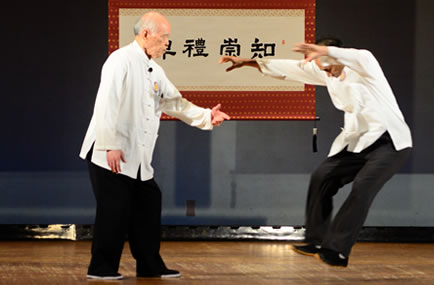
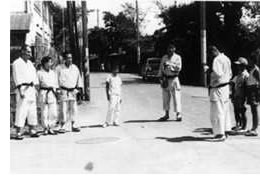


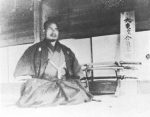
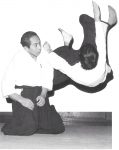



Leave a Reply